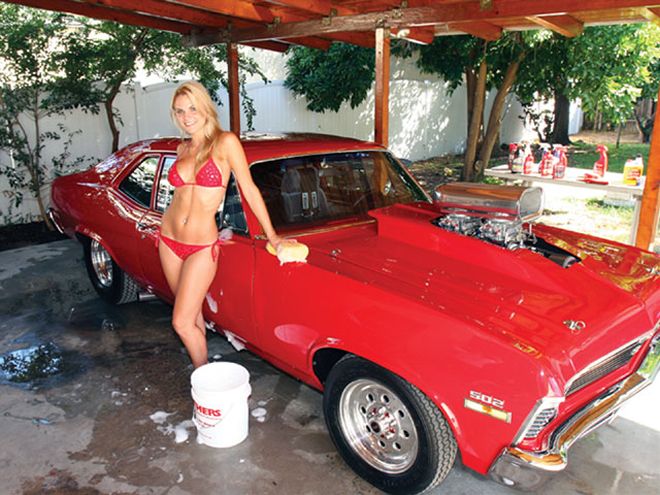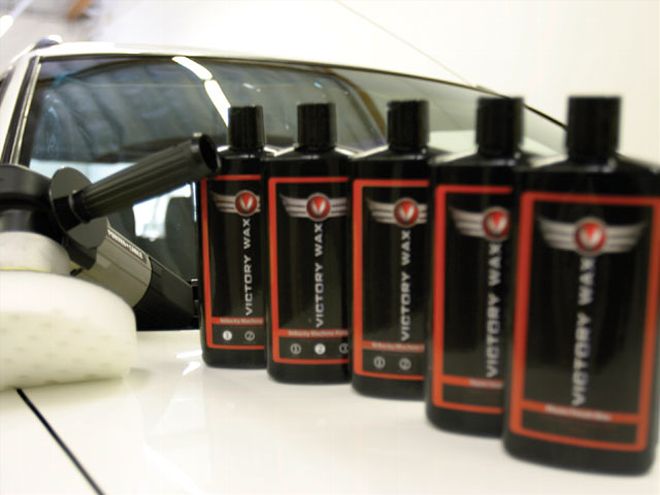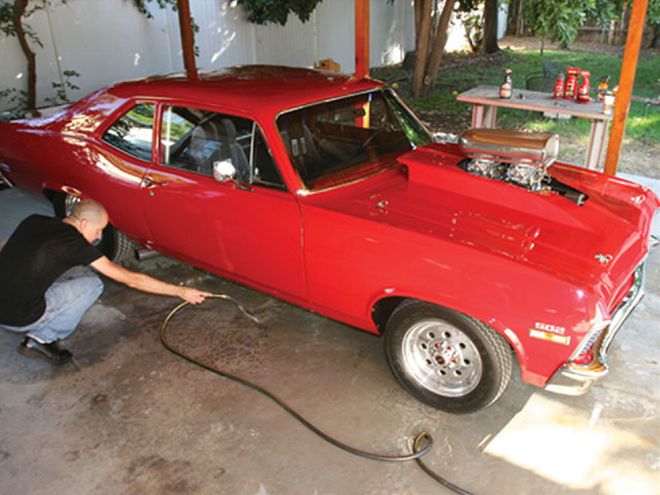

'It's not that bad, really. Some people balk at the notion of spending half a day cleaning and detailing their cars. We're here to reassure you there is no black magic involved in detailing. You just need to be able to recognize which products to use for each surface and condition. Combine that with some manual labor and a few hours, and your car will be looking like new. Plus, the more often you do it, the easier it will be, and the longer your paint job will last.
Now, we are fully aware that photos of a bunch of dudes washing a car might cause more than a few of our readers to fast-forward through these next five pages. Our more impassioned readers might even send hate mail, so we thought we'd mix things up a bit. Feast your eyes on the beautiful Paige Peterson as she tackles detailing duties on Greg Nicholl's Nova. You can thank us later.
Wheel/Tire Cleaner
They say you should wash the car from the top down, but we're not ones to always follow convention-we actually like to clean the tires first. It's been our experience that tire cleaners work best when applied to dry tires. It seems to break up old tire dressing better that way. So we clean both the tires and wheels first before a drop of water even touches the car.
Those "no touch" hose-off tire cleaners work OK, but the best products still require scrubbing, so spray liberally and use a scrub brush to get rid of all the road grime and brake dust. To clean the wheels, it's best to use one of the newer, all-metal wheel cleaners to avoid damaging the finish. They're formulated to work on bare aluminum, magnesium, or painted wheels. Soak the wheels with the cleaner and scrub lightly with a soft-bristle brush or an old terry-cloth towel. Rinse both the wheel and tire thoroughly. Do one wheel at a time to prevent the cleaners from drying before you rinse them off. If you have unpainted wheels, they can then be cleaned with mag and aluminum polish. Use a terry-cloth towel to wipe the polish on, and wipe the residue away with a clean towel. Be sure to use old towels, though-the polish turns black as it cleans the metal.
Wash
It's not rocket science-the foundation for any detailing job begins with a thorough washing. For best results, wash your car in the shade, and use car-wash soap rather than dish soap or another type of cleaner. Mix in enough soap so that the water feels a little slippery between your fingers. Rinse the entire car first to remove larger particles of dirt, then use a thick wash mitt or high-nap terry-cloth sponge to apply the soapy water. These dense applicators will trap any dirt and particles and prevent them from scratching the paint surface. It's best to work a section at a time, rinsing after each to keep soap residue from drying on the paint. Once done, dry the car with a soft terry-cloth towel, a water blade, or our favorite, The Absorber synthetic chamois.
Polish
Paint gets its gloss by reflecting light-the more it reflects, the glossier it looks. But the paint's surface must be as smooth as possible in order to reflect the greatest amount of light. Conversely, scratched and damaged paint looks dull because its rough surface does not cast back as much light. Think of suede or a primer job-it's not glossy because the surface is not smooth. The surface of your topcoat will wear out in time too. Freeway driving acts like a sandblaster, bombarding the paint with grit and particles. Combine that with excessive sunlight, hard water, bird droppings, and careless people brushing up against your car, and eventually your paint appears faded because of tiny scratches that have developed with time and use.
One option is the clay bar, which works by picking up small particles of dirt and minerals left behind in water spots. The paint needs to be wet so the clay will glide smoothly over it, so spray the area with quick detailer first. Rub the clay lightly across the paint until it feels smooth. Dry with a soft towel and move on to the next section.
Clay bars only remove contaminants embedded in the paint, however, so what do you do about scratches? Sometimes, a coat of wax will fill light scratches and revive the shine. Try a light coat on a small area to test. If it doesn't work, you'll need to break out the big guns.
Polish is a very general term referring to a range of products that remove or fill in scratches, usually by means of abrasives. Other names you'll see on parts stores' "wall of wax" are cleaners, cleaner wax, swirl remover, and glazing compound-clever terms, but they are all types of polish. Most brands market their polishes in steps from mild to heavy, so you'll probably have to buy all three and experiment-be sure to start with the mildest formula first, though. Polishes can be applied by hand using a foam applicator or by machine. Apply the polish and buff until the scratches fade; it should take less than a minute. Then wipe the residue off with a microfiber towel. If the scratches are still there, move up to the next higher formula. Keep moving up until the scratches are gone. Smooth out any areas where you used the rough stuff with a final coat of the mild formula prior to waxing, and your paint will look a mile deep.
Wax
Someone described wax to us awhile ago as a coating that keeps the paint from drying out. Paint, like most other materials in your car, will oxidize, fade, and break down over time. Wax is like a moisturizer for your paint. More than that, it provides a layer of protection against the sun's UV rays, dirt, and grime-all the crap you want to keep off your car. The best waxes are made from carnauba, an oily substance that comes from the leaves of a palm tree native to Brazil. Did you ever notice the way water beads up on some plant leaves as if they were waterproof? Some brilliant guy decided to put this stuff on his paint, and it worked.
Paste wax requires more effort to apply, but the finish lasts longer than liquid wax. However, we prefer the liquid stuff. It goes on quickly, and we don't mind waxing our car more than twice a year. Apply wax with a soft sponge applicator, wait for it to dry to a light haze, and wipe the residue with a microfiber towel.
Tire Dressing
Make no mistake, we're not advocating bling in Car Craft, but tire shine is good stuff. Like paint, the rubber used to make tires also oxidizes and breaks down over time. When that starts to happen, your once-black tires start to turn an unappealing shade of brownish grey. Not cool. Tire dressing shields the rubber from the environment and slows the aging process. We like the stuff made with silicone that you wipe on rather than spray on; that way you avoid coating the wheels with it as well. Pour a few drops on an old cloth or rag and wipe it on the tires.
Trim
You wouldn't want a glossy paint job taking up space next to dull-looking trim, would you? The same polish you use to clean your wheels can often put a shine back into your chrome and stainless trim. Put a small amount on an old towel and wipe until the shine comes back. Oftentimes the towel will be jet black by the time you're done-it's amazing how dirty these parts can get. Some newer cars have rubber and vinyl trim in addition to or instead of chrome trim. We like to use tire dressing on those parts that are more susceptible to environmental damage, especially from sunlight. While you're at it, you can wipe your weatherstripping with tire dressing, too. That will help keep it from drying out and cracking.
Maintenance
Though we've heard of some people who wash their cars every day (not a good idea, by the way), the more realistic method of keeping your car shiny in between washings is to use quick detailer. If the car is dusty, wipe it first with a car duster, spray on the quick detailer, and wipe it dry with a microfiber towel. It's fast and easy. Be sure to use the softest towels possible, though, in order to avoid scratching the paint.
Interior
It does not take a lot of effort to keep your interior in top shape. But a neglected interior will draw angry looks at cruise night. California Car Duster makes cool, dashboard-sized dusters that you can hide under the seat. Once a month, wipe the dash with a vinyl protectant. It helps keep the dashpad from cracking over time. We prefer the low-gloss products. Metal dashboards and trim also benefit from polish and a coat of wax.
Deep scratches and Machine Polish
Unless you keep your car in a bubble, it's only matter of time until the paint gets scratched. No need to panic, though, when that happens. Here's how we took dog toenail scratches out of one of our commuters. (Greg's Nova was too nice to demonstrate on.)

Think of rubbing compound like sanding body filler or primer. You start with a heavy grit and work down to finer grits. The same holds true with rubbing compound, which really is like liquid sandpaper. After applying the compound, you now need to smooth out the area with a less abrasive polish and follow up with a coat of wax. Victory Wax is a new company that is marketing a line of products specially designed to be applied by a random-orbiting polisher. The kit Victory sent us included the polisher, pads, and several bottles of polish, wax, and quick detailer, and we were impressed with the ease of use and quality of the finish when we were done.

'No water has touched Greg's Nova since it was painted. He keeps it garaged and maintains its shine with quick detailer. Here's us mocking up the car wash scene for the photo shoot.
Blown Nova Tech Notes
Who: Greg Nicholl, rental manager for John Deere (but this ain't no tractor)
What: '72 Chevrolet Nova
Where: Camarillo, California, where he takes the car to to get groceries
Short-block:
The car had a 396ci big-block when Greg bought it in 2005, but he quickly swapped in a Chevrolet ZZ502 crate engine with extensive work by Larry Kraszewski of Camarillo Auto Service. At the center spins a forged-steel crankshaft that swings 9.6:1 forged-aluminum pistons and rings on forged-steel connecting rods. A Chevrolet hydraulic roller cam provides 224/234 duration at 0.050 and 0.527/ 0.544-inch intake lift.
Heads:
The Edelbrock aluminum heads have 110cc chambers. The stainless-steel Chevrolet valves are 2.25 inches on the intake and 1.88 inches on the exhaust, all actuated with aluminum rocker arms.
Induction and exhaust:
A pair of Holley 750-cfm carbs gets high-volume air from an 8-71 supercharger built by The Blower Shop in Santa Clara, California. (Greg's wife went on vacation, and the huffer was in place when she got back. Stuff happens.) But the blower wasn't enough, so Greg had Jim Bassett of Bones Fab in Camarillo add a 200hp NOS Cheater setup that is fed by its own Barry Grant fuel system in addition to the BG 250 fuel system for the carbs, which siphon gas from a Jaz 15-gallon fuel cell. All of the lines are aluminum or braided steel. The exhaust exits through 2 1/4-inch Hooker headers with 4-inch collectors into 3-inch stainless tubing and Hooker mufflers.
Electrical and cooling:
Cooling comes from an Edelbrock aluminum water pump that circulates through a Griffin aluminum radiator with twin electric fans. Spark comes from an MSD 7AL box through an MSD billet distributor and coil, MSD wires, and a Powermaster 140-amp alternator that charges an Optima battery. A Moroso 7-quart oil pan is serviced by a Moroso oil pump and pickup.
Drivetrain:
Because the Nova is driven regularly, Greg kept the drivetrain straightforward and serviceable, but he used stout components to match up with the big-block. The TH400 transmission received a B&M manual valvebody and a B&M trans cooler. The tranny is fitted with a TCI 3,000-rpm-stall converter, and the driveshaft and U-joints are standard Chevy issue. The differential is a Ford 9-inch with a Currie third member that is fitted with a Currie 4.10:1 Posi and turns Strange 35-spline axles.
Chassis:
There's no mistaking the intent of Greg's Nova: Go fast and track straight. The foundation is an S&W race car back half with Koni coilover shocks, a Hotchkis four-link with a rear-end locator bar, and Competition Engineering subframe connectors. The rear meats are 29x18.5-15 M/T Sportsman Pros mounted on Weld Drag Lite 15x15 wheels. At the front end, Goodfella's Rod and Custom of Camarillo redid the suspension using Moroso springs with 70/30 Lakewood shocks and a Hotchkis 1-inch sway bar. A set of Global West upper and lower tubular A-arms control the front 26x7.50-15 M/T Sportsman rubber wrapped around 15x7 Drag Lites. The steering is stock Chevrolet, and Wilwood discs handle the braking at each corner.
Paint and body:
Weight being a consideration, Greg installed a Harwood 4-inch fiberglass hood and a Harwood fiberglass rear deck with an 8-inch stainless steel wing. The gimme-a-ticket paint is PPG So-Cal red, and the shine came through the labors of Michael and Nicholas Codina of M&N Custom Works Detailing.
Interior:
The interior is also set up for racing, with custom seats by Superior Interiors Upholstery in Camarillo, California, Crow five-point harnesses, and an eight-point rollcage. The custom upholstery and door panels were also stitched by Superior Interiors Upholstery, and the gauge package is all Auto Meter, including Pro Comp oil, water, voltage, and fuel monitors as well as a Pro Comp tach. The steering wheel is from Billet Specialties, and the shifter is a Hurst quarter-stick. With the Sony CD/XM radio stereo pounding out sound from an 800-watt amp through speakers in the headrests, Greg can probably even listen to tunes with the big-block running.
Performance:
The combination works. The Nova has turned a 10.13 quarter at 130 mph in street attire with no bottle, and the dyno squealed under 870 hp and 850 lb-ft of torque.